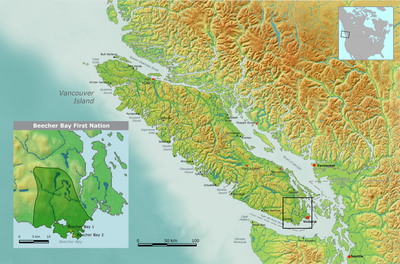Beecher Bay First Nation
The Beecher Bay First Nation (rarely Becher Bay) or Scia'new First Nation is one of the Canadian First Nations in the province of British Columbia and belongs to the coastal Salish group . The members of the First Nation live as one of the 19 Salish tribes on Vancouver Island in the southwest of the island - on the eponymous Beecher Bay. You are one of the four tribes of the Klallam , but the other three live in Washington State , more precisely on the Olympic Peninsula . In October 2009, the Department of Indian Affairs and Northern Development recognized 234 people as members of the tribe, up from 262 in July 2019.
history
- see History of the Coastal Salish
Early history
The settlement area of the four Klallam tribes was on the coast, only a few villages were inland. The villages, some of which were only inhabited seasonally, conducted an intensive trade. As everywhere on the west coast, this was mostly done on canoes , whereby the canoes themselves were also commercial objects.
Contact with Europeans
Robert Duffin was probably the first European in the area of the Beecher Bay people in July 1788. The visit of the ship under the leadership of the Spaniard Manuel Quimper in July 1790 probably brought in the first smallpox epidemic , at least among the Lower Elwha Klallam, because in 2005 at least 335 skeletons were found. The first contacts with Europeans brought epidemics such as smallpox, but also measles , flu , etc. So the Hudson's Bay Company estimated the number of Klallam in 1845 at 1760, ten years later only at 926. Their relatives in the USA suffered another smallpox epidemic in 1862 victim at a time when the US authorities were still unsure how to deport them to a reservation. In addition, the pressure from the new settlers increased, so that the tribe split up (see Klallam ).
In 1877 the reserve was assigned to them. In 1881 the Klallam in Beecher Bay numbered only 75 people. Their chief was Kla-a-hum, who was 50 years old at the time. Quit-ka mum was her medicine man. 12 men reported to be fishermen, 7 farm workers. The 23 families were rather small for the conditions of the time and had a maximum of six members.
When the McKenna-McBride Commission visited the reservations from 1913, they determined that one of the three reservations in Beecher Bay should be closed. Reservation # 1 , 502 acres , and # 2 , 235 acres, were to remain, and # 3 , located at Creyke Point, was to be withdrawn. Reserve No. 4, Wolf Island, has also been drafted, and other tiny reserves have been confirmed. It was in detail
- No. 5 - Lamb Island (0.50 acre );
- No. 6 - Fraser Island (14)
- No. 7 - Village Island (3)
- No. 8 to 10, further, not specifically designated islands of 2, 4 and 1 acre area. These Commission proposals did not become legally binding until 1923.
Reservations
Beecher Bay now has eight reserves. The largest are Beecher Bay 1 and 2 with 202.7 and 95.1 ha respectively. Five more are on islands in or in front of the bay, more precisely on Lamb Island (0.2 ha), Fraser Island (5.7 ha), Village Island 7 comprises three islets with a total of 1.2 hectares, Whale Island 8 on Bedford Island (0.8 hectares), Long Neck Island 9 on Large Bedford Island (1.6 hectares), and finally Twin Island at the entrance to Parry Bay (0.4 ha).
In August 2009 there were 237 tribesmen, of whom 106 live in the reservation, 7 in other reservations and 124 outside; in April 2016 this was 102, 11 and 141 respectively.
Current situation
Burt Charles, chief of the Scia'new First Nation , called in 2000 to support the Mi'kmaq in their fight for fishing rights. He went salmon fishing without worrying about bans. Members of the Te'mexw Treaty Association , which, in addition to the Beecher Bay, include the Malahat , Nanoose , Songhees and T'sou-ke , demonstratively went fishing. The neighboring T'sooke even sold their seafood to the public.
literature
- Wayne Suttles: Affinal Ties, Subsistence, and Prestige among the Coast Salish . In: American Anthropologist New Series 62, 1960, 2, ISSN 0002-7294 , pp. 296-305.
- Brian Thom: Coast Salish Transformation Stories: Kinship, Place and Aboriginal Rights and Title in Canada , Department of Anthropology, McGill University 1998, online .
Remarks
- ^ Beecher Bay , Indigenous and Northern Affairs Canada.
- ↑ Lynda V. Mapes: "How could so many die?" Graves may tell story of terrible epidemic . In: The Seattle Times , May 23, 2005. Retrieved August 11, 2011.
- ^ BC Archives, Joint Reserve Commission records, Box 1, Number 2, 1352/77, Minutes of decision, June 11, 1877.
- ↑ The 1881 census can be found here: Census Search . In: viHistory . Retrieved August 11, 2011.
- ↑ The published text: Minutes of Decision - Becher Bay Tribe .
- ^ The published text: Minutes of Decision - Chemainus Tribe .
- ↑ According to First Nation Profiles: Beecher Bay ( memento of the original from March 6, 2016 in the Internet Archive ) Info: The archive link was inserted automatically and not yet checked. Please check the original and archive link according to the instructions and then remove this notice. .
